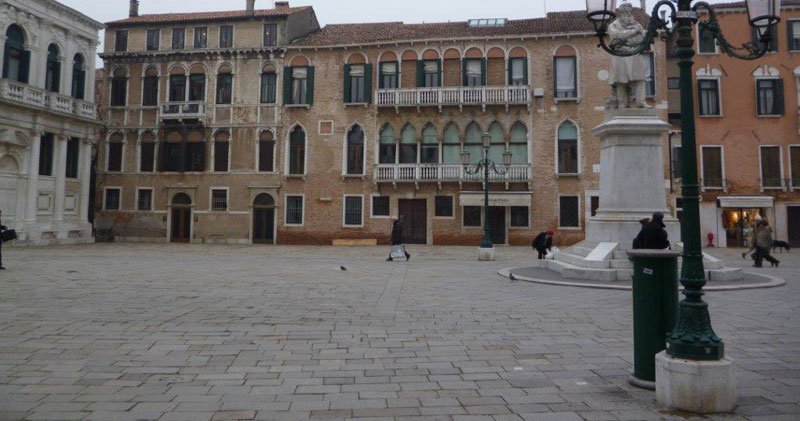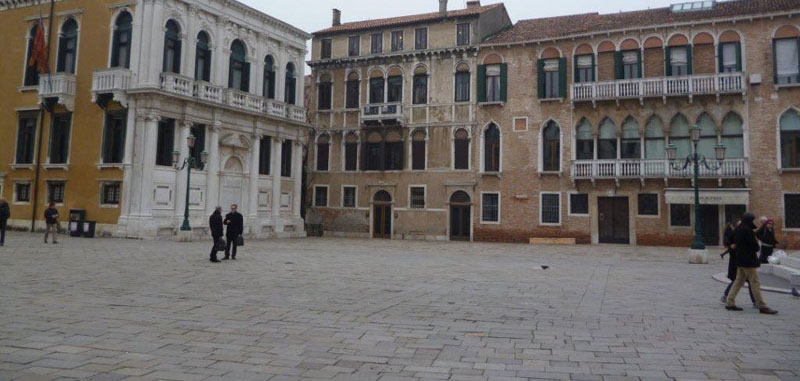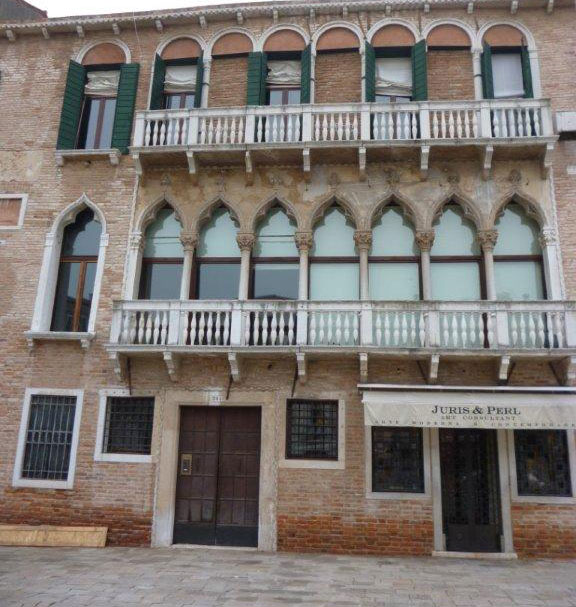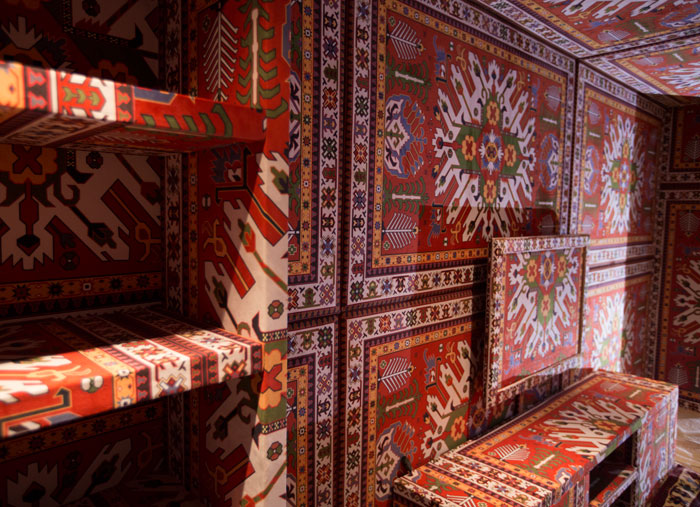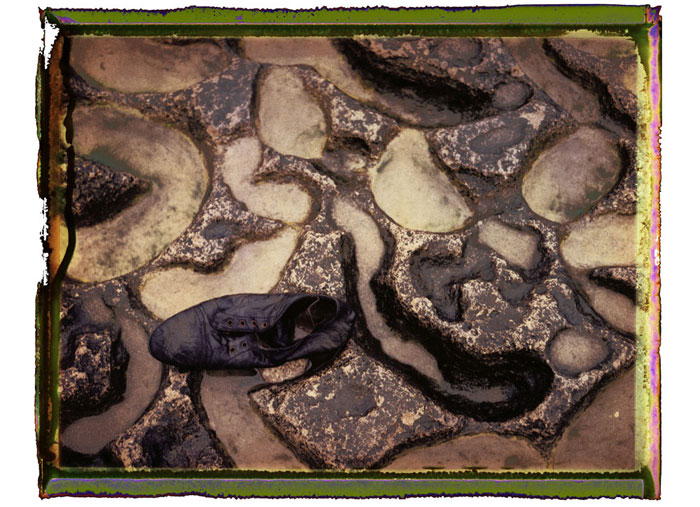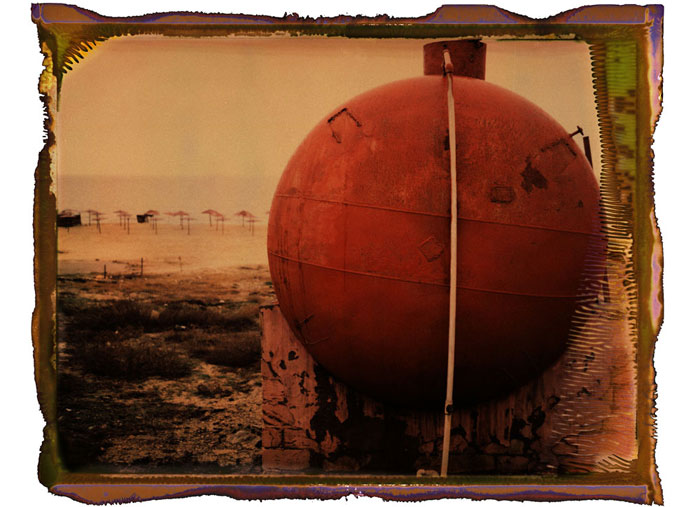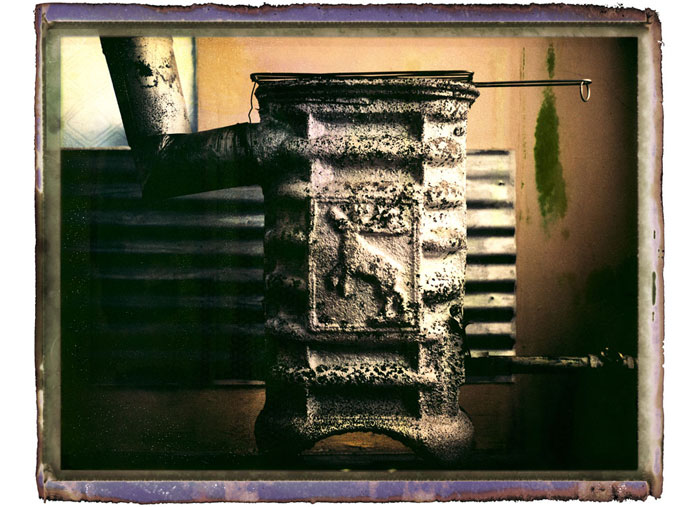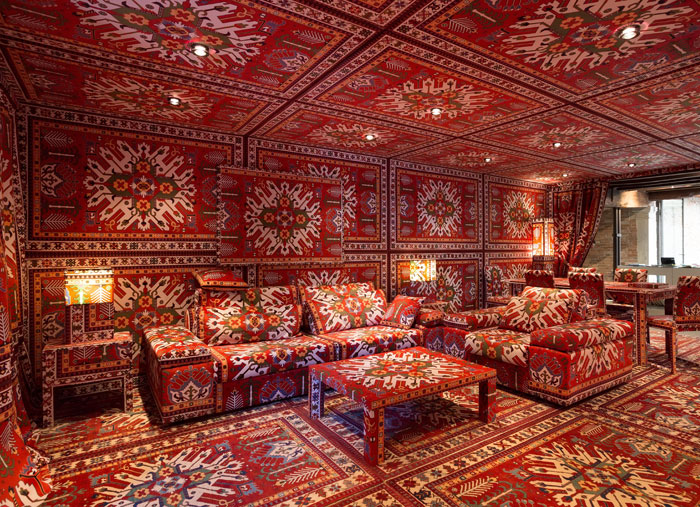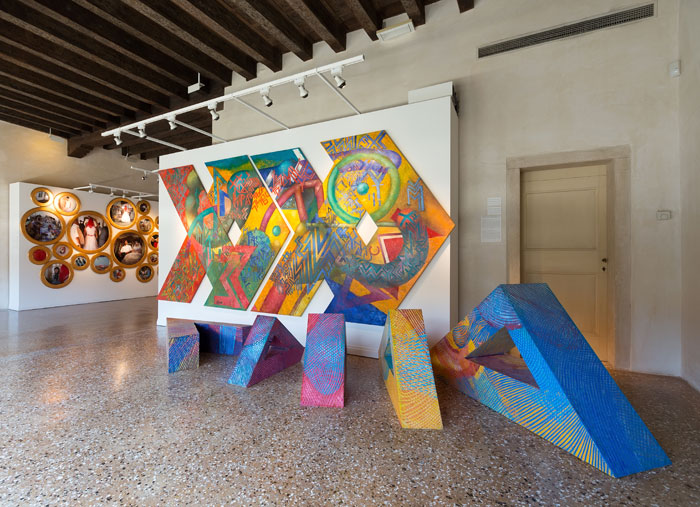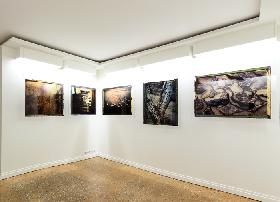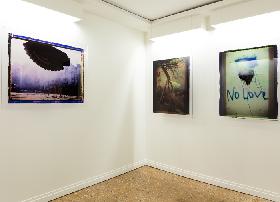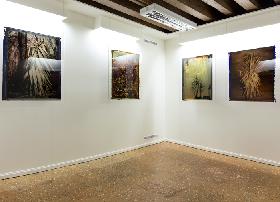
When did art penetrate the human life? Hardly anyone can answer this question. But, beyond any doubt, that is art which in ancient times laid the foundations of morality and spiritual world. Once started, the process of creative exploration has been going on for millennia. In fact, the forms and the methods of expression are being changed. Art, however, continues to break the boundaries of time and space by merging the past and the future as well as linking the cultures and civilizations.
This is certainly the case with the Azerbaijani art, whose history goes back thousands of years. Famous Petroglyphs of Gobustan near Baku are now called "the oldest art gallery" ever. Among the rock carvings one can not only see the images of people, animals and the famous "solar boat", but also the first geometric patterns of future ornaments, which in all historical epochs remained an important part of the fine art of Azerbaijan. Extant museum artifacts enable to track the development and evolution of ornamental studies as it was becoming more sophisticated in forms with appearance of new motifs and compositions.
The long history of our nation is as if encrypted in traditional ornaments of famous Azerbaijani carpets in the stone sculpture and embroidery. Throughout many ages Azerbaijan has played the role of a bridge and an open gate between the East and West, North and South. On the Caspian Sea shore, where the first states date back to the 2nd-1st millennium BC, the empires succeeded each other, and every single one of them left their footprint on the cultural and aesthetic traditions of the Azerbaijani people. The Great Silk Road passed through the territory of our country and thus created its own unique fusion of cultures and civilizations. In the richness and variety of patterns and compositional solutions embedded in Azerbaijani national ornaments, one can trace how Islamic motifs are combined with the heritage of Zoroastrianism and Christianity, and Ancient art traditions are intertwined with the Caucasus. They feature magic symbols that carry the traces of ancient beliefs, allegorical images of fabulous characters and fantastic animals.
Azerbaijani ornaments are considered to be an "artistic alphabet" of the people. As the basis of applied art, they now decorate our carpets, dishes, clothes, walls of palaces and ancient temples. These ornaments have created a kind of aesthetic environment.
Ornament studies incorporate the quintessence of history and culture of Azerbaijan, and inspire modern Azerbaijani artists today. They bravely use new forms of creative expression by combining traditional techniques and conceptual art. Their works are characterized by an aesthetic continuity, along with innovative ideas interwoven with the ancient art traditions. Today, the works of modern artists feature fine ornamental compositions in new sense and philosophical reinterpretation of the historical and cultural heritage, which is a prerequisite for genuine creativity and spiritual development.
The works presented at the Venice Biennale in 2013 are very different indeed. These are sculptures, paintings and installations. Modern Art of Azerbaijan was not a prisoner of frozen shapes and did not lose its traditions either. It is, indeed, as the three flame tongues on the coat of arms of Baku which combines the traditions of the past, the present and the creative quest turned to the future - just as our ancient, eternally young and rapidly developing Azerbaijan.
The meeting with art of our country, I hope, will be interesting for you, because regardless of the variety of artistic heritage of different peoples and civilizations the very language of creativity and beauty is understandable to everyone.
Mehriban Aliyeva
President of the Heydar Aliyev Foundation
First Lady of Azerbaijan

ORNAMENTATION
From Baku to Venice : six contemporary artists from the land of fire.At the crossroads of Orient and Occident, Azerbaijan is surrounded by many countries and different cultures. The inhabitants have always been in contact with merchants – Arab, Chinese, Russian, Slavic etc.- who progressively introduced goods such as coffee, tea or bortsch. Later, with the oil industry development (19th-20th centuries), new influences have appeared.
Ornamentation is the main aspect of the Azerbaijani culture. The linear characteristic of the ornament is the idea of infinity of life. This feature has always been present in the national history of art. The decorative arts, which history goes back to the Paleolithic age, are among the most ancient visual languages. Rock paintings and engravings (petroglyphs) were discovered at Gobustan. Theses works present prehistoric scenes such as hunting, lifestyle, collective dance, canopy of heaven, animals and vegetables. This site highlights a cultural continuity between prehistoric and medieval times. Pattern emerged in the Upper Paleolithic period (between 35 000 and 10 000 years BC). At that time, ornament had a symbolic meaning, and consisted of geometric shapes. By this way, the people expressed their understanding of the world structure. The circle represented the sun, a triangle - the mountains, the square - the land, the spiral - the development, the swastika - the movement of the sun. In time, the signs and symbols became aesthetic expression and the ornament became more decorative. The use of ornaments represents this transition to a symbolic thinking. When the era of agricultural societies started, geometric abstraction became a real art expression by creating a complex system of symbols.
In Azerbaijan, different religions and traditions such as Zoroastrianism, Islam and Christianity highly influenced the culture. Daily life also represents a constant source of inspiration for creation through clothes, jewels, decoration, carpets weaving, architecture and embroidery. The notions of fire and home – which represent the family – are essential values in this culture. There are different types of ornaments: carpet design, heraldic decoration, built on the symmetry of the ornamental elements. The ornaments can be composed of geometric elements of stylized images of plants, animals and human figures. Graphic pattern is used in arts and crafts, fine arts and graphic arts. The sculptural decoration is used in architecture. Architectural ornament reveals details of tectonics plate and affects the perception of space.
The Azerbaijani monuments and ornaments reflect the complex national history, from the antique artistic tradition (Neolithic period) to the most recent buildings in Baku. The geographical and climatic conditions permitted the creation of new kind of buildings but the main impact on architecture was cultural and political. Fortifications, ramparts and other defensive buildings appeared to protect the territory (State of Manna, Sassanid period…). In the 7th century, with the Arab invasion and the diffusion of Islam in the country, the architecture changed a lot with the construction of mosques, caravanserai etc. In parallel, Christian temples and fortresses were also built (Djavanshir fortress, 7th century). Many buildings, settled in different periods, are based on religious symbols and on the fauna and flora. For example, the ornaments on the Divankhana pavilion (15th century, the Palace of the Shirvanshahs, Baku) are composed of fig leaves from the Absheron flora and engraved Koranic verses. Different schools of architecture opened during the 10th and 11th. Architects and ornamentalists started to work abroad in the 15th – 16th century. This period is characterized by the development of old traditions and oriental constructions (hammams). For example, the Sheki Khan Palace (1763) was constructed in wood with the traditional shebeke process (patterns made with wood crosspieces). During the Soviet period, the number of gothic private mansions (French or Venitian style) and public building (Fine arts museum, Douma) increased. The Ismayilliya building was initially decorated with Koran verses that were replaced by the Soviet star by the government. It is a great example of the multiples influences present in the architecture. Finally, the independence of the country represented a new step in the architecture: a mix between oriental and occidental influences.
Another important cultural reference and well renown craft is carpet-making. Carpets have their own language combining different patterns revealing coded messages. The carpets are part of the Azerbaijani people life and a part of their vision of aesthetic. The first carpets dates back to the Bronze age. Carpet weaving was traditionally reserved to women, the carpets called “Dast-khali-gaba” were components of their dowry. It can also refer to the legend of the Virgin Mary and the embroidered veil of the temple in Jerusalem. The decorative arts and geometric and floral ornaments developed with the diffusion of Islam and the restriction in the figure representation. Two types of carpets exist: tied or woven. Each region made a particular type of carpet. Some schools were created, according to the regions: Guba, Baku, Shirvan, Gandja, Gazakh, Karabagh, Nakhtchyvan and Tabriz. In each school, ornaments, geometric shapes, compositions, colours, threads and drawings are different and recognizable. The Azerbaijani people can identify and interpret a carpet. This codded language is little known by the other cultures in the world and this mystery can be fascinating.
During the 14th and the 15th centuries, the European painters started to introduce Azerbaijani carpets in their works. The ravishing play of colours and dizzying geometric patterns was a sign of exoticism. On the canvases of Memling, Holbein, Van Eyck, Carpaccio, Vermeer, the carpet is not just painted on the background, it is sometimes related to the main character on the foreground. For example, a carpet of "Zeyva" is inscribed in the painting "Madonna Canonica" by Jan van Eyck (15th century). In the "Scenes from the Life of Aeneas" by Pinturicchio is depicted the rug of "Ganja" and in the 15th century Dutch painter Hans Memling included images of Azerbaijani carpets in several works, among which the famous triptych dedicated to the Virgin Mary. The carpet was a symbol of wealth and a sign of high culture and Amsterdam, as one of the centres of European trade, was the perfect market for eastern exotic goods, and only the Flemish were able to distinguish the true from the lowbrow art crafts.
Nowadays, a new generation explores and updates this traditional art through a contemporary vision, raising the essence of ornament in relation with the perception of the national cultural heritage as a major artistic question. Using a traditional carpet, characteristic of the Karabakh region of Azerbaijan, Farid Rasulov creates a site specific and surrealistic environment. Fakhriyya Mammadova describes with her photographic installation: « Wedding : Girlish Dreams » a wedding ceremony mixing tradition and modernity. Sanan Aleskerov’s unique photographs, like impressionist paintings, shows his « everyday concept of the beauty of simplicity » either in a plant or a simple piece of furniture. Rashad Alakbarov, using shadows as a theatre of the world, creates different types of ornaments that can be found in Eastern or European civilizations. In his paintings full of virtuosity, Butunay Hagverdiyev plays with signs and reminds us that Azerbaijan changed alphabet three times in one century. Chingiz erases history and rewrites it all over again using twentieth-century symbols on a blank medium.
Azerbaijan recovered its independence in 1991. History and Geography have made it one of the most interesting countries of the 21st century. There are so many kinds of artists who show the diversity of the country giving us universal messages. Preserving the past and building the future is one of them.
Herve Mikaeloff
Curator of the exhibition


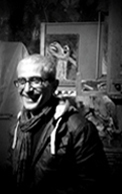

.jpg)

Lives and works in Baku, Azerbaijan Rashad Alakbarov graduated from the Faculty of Decorative Arts at Azerbaijan State Academy of Fine Art in Baku in 2001. He works with different media, including painting, sculpture, theatre decoration, v
MoreLives and works in Baku, Azerbaijan Fakhriyya Mammadova is an artist, designer and photographer. She graduated from the Design Faculty of the Azerbaijan State Academy of Fine Art in Baku in 2005. She has been a member of the Union of Artists o
MoreLives and works in Baku, Azerbaijan Website: www.chingiz.artsetc.org CHINGIZ graduated with an MFA degree from the Azerbaijan State University of Fine Arts in 1991. Since 1986, he has worked as a conceptual artist with sculpture, p
MoreLives and works in Baku, Azerbaijan Website: www.sananart.com Sanan Aleskerov graduated with a degree in journalism from Azerbaijan State University in 1982. He worked with scientific, applied, press and other types of photography.
MoreLives and works both in Moscow, Russia and Baku, Azerbaijan www.herachy.cc Butunay Hagverdiyev graduated from Azimzadeh Art College, paining faculty in Baku in 2009. Since 2011, he studies at the British Higher School of Art and De
MoreLives and works in Baku, Azerbaijan Website: www.faridrasulov.com Farid Rasulov graduated from Azerbaijan State Medical University in 2006. In 2007, having decided to step aside from medicine, he started to actively engage wi
More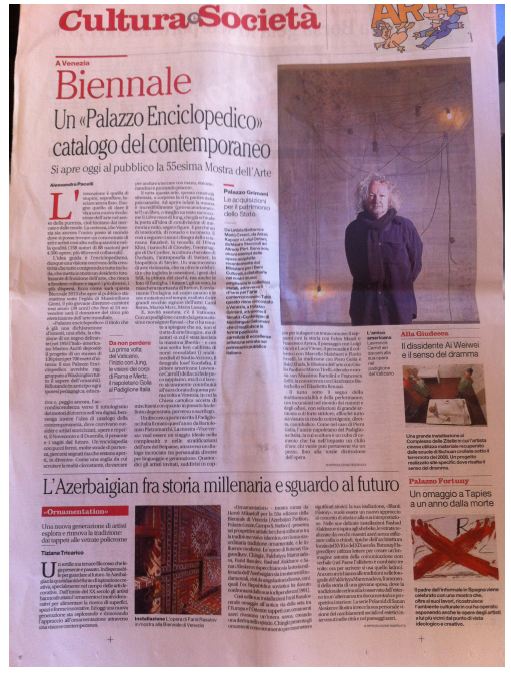
More than 20 public (online) pages (newspapers) published news and information about the ORNAMENTATION at Biennale exhibition in Venice. Each information source gave interesting views and thoughts on the Azerbaijan pavilion. All the published news...

55th International Art Exhibition – la Biennale di Venezia
1 June – 24 November 2013
The Republic of Azerbaijan at the 55th Venice
Biennale presents ORNAMENTATION
Butunay Hagverdiyev | CHINGIZ | Fakhriyya M...
ARTPRESS – Ute Weingarten | Elisabethkirchstraße 15 | 10115 Berlin | Germany
+ 49 30 48496350 | [email protected] | www.artpress-uteweingarten.de |
Please find press images here: http://www.artpress-uteweingarten.de/en/presselounge/
Sara Benetti | PDG Arte Communications | +39 041 5264546 [email protected] | www.artecommunications.com
Laura Corsico | ITMG | +39 06 69923385 | [email protected] | www.itmg.it



